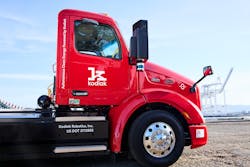ANAHEIM, California—Autonomous trucking technology can reduce long-haul fuel consumption by about 10%. Self-driving trucking company Kodiak Robotics wants to take that sustainability to another level with its new autonomous battery-electric tractor integrating into its fleet.
The AV company will unveil a Peterbilt Model 579EV electric truck upfitted with the Kodiak Driver self-driving technology here at the Advanced Clean Transportation Expo on May 2. The self-driving Class 8 EV will be displayed in booth No. 5421 at the Anaheim Convention Center through Thursday, May 4. After testing, Kodiak plans to integrate the EV into its fleet in 2024.
“We’ve been interested in sustainability and zero-emissions technology for a long time,” Andreas Wendel, Kodiak Robotics’ CTO, told FleetOwner before the truck’s unveiling. “A lot of our employees drive electric, even hydrogen, vehicles. It’s where we think the freight industry will go over time. At the moment, a lot of these vehicles are very short-range—but that doesn’t prevent us from actually starting to integrate and show the future benefits.”
See also: Kodiak to operate 24/6 autonomous freight between Dallas and Atlanta
The Peterbilt 579EV has a range of up to 150 miles on a single charge and can be recharged in as little as three hours, depending on the charging infrastructure. The EV was designed for short-haul and drayage deployments. But Wendel said that wouldn’t prevent Kodiak from testing it on longer runs.
“The miles they drive will actually change—it will get more over time—be it with battery-electric vehicles or fuel cell-electric vehicles,” Wendel said. “But for us, it’s really to show the adaptability of our Kodiak Driver system, both the hardware and software to integrate on these vehicles.”
Preparing for trucks of the future
Wendel explained that Kodiak’s autonomous system is vehicle- and powertrain-agnostic, allowing it to be integrated into emerging truck platforms as they become available, regardless of fuel type.
Kodiak purchased the Model 579EV from Peterbilt. It is the second vehicle platform—the other being traditional Class 8 diesel tractors—that Kodiak equipped with its fifth-generation sensors.
AV competitor Einride has set out to only offer self-driving freight EVs in the U.S. and Europe. Some of its products are freight pods with no cab, and it also has regional Class 8 self-driving EVs.
Einride’s North America GM, Niklas Reinedahl, recently told FleetOwner that combo technologies “maximize sustainability and efficiency.” The U.S. and European fleets using Einride’s equipment have reduced CO2 emissions by 95% compared to the diesel-fueled tractors they replaced.
“Self-driving technology allowed us to remove drivers from the trucks and put them in remote operations while also designing cabless trucks that are more aerodynamic,” Reinedahl said. “As a result, we save precious weight that maximizes the charge of a battery and extends the range of our trucks.”
See also: Kodiak awarded DOD contract to develop autonomous Army vehicles
While Einride is creating its own vehicles, the Kodiak technology is designed to be added to any Class 8 commercial vehicle.
“We believe that the future of trucking is the combination of electric and autonomous vehicles,” said Don Burnette, founder and CEO of Kodiak Robotics. “Given advancements in battery and fuel-cell technologies, achieving zero-emissions trucking will soon be within reach. Kodiak’s work on the Peterbilt Model 579EV will help us gain valuable experience in how to build autonomous electric vehicles and help us realize that vision. Customers have been long asking for an autonomous electric vehicle, and we are delivering on that need.”
Kodiak plans to explore other sustainable vehicle platforms, such as fuel cells, as they come to the market.
Wendel said that Kodiak has been making traction in its drive to create humanless freight transport in the U.S. through its work with test fleets, such as furniture retailer Ikea’s Supply Chain Operations division. “It is amazing to see how our technology is being adopted—both from a shipper and fleet perspective,” he explained. “I believe that traction really comes from us listening to our customers.”
Right now, Kodiak wants to show current and potential customers what is possible with the Kodiak Driver. “At the moment, we’re developing these modifications and really tuning it to our high-reliability standards that customers have gotten to expect from Kodiak. Then we’ll be really integrating it into our system so that fleet can actually see there’s an electric truck out there, and this is how it would be used at the moment in full autonomy.”





